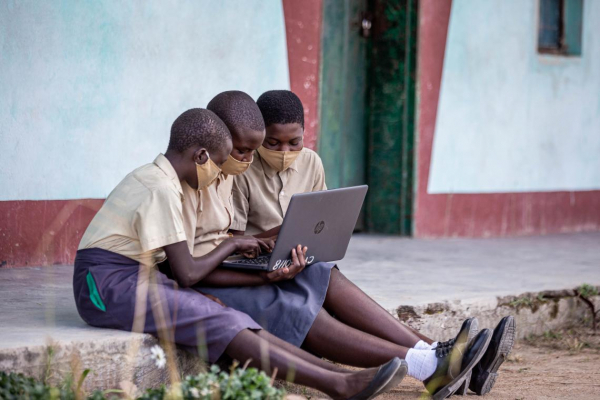
The COVID-19 pandemic has affected the learning of millions of children around the world, including 4.6 million children in Zimbabwe. When the COVID-19 virus began to spread in the country in March 2020, forcing the country into a nationwide lockdown, no one knew how long it would last or the impact it would have on children’s learning
Since the start of the pandemic, Zimbabwe has followed a phased approach to school closing and reopening. Schools were fully closed for face to face learning from March to Mid-September 2020, partially reopened from Mid Sept-Oct and then fully reopened again from Nov-Dec 2020. From Jan 2021 to March 2021 schools were partially reopened but they are now fully open since beginning of April 2021.
In the face of the pandemic and during the whole of 2020, the country has been developing alternative ways to ensure continuity of learning. In the first months of the pandemic, this meant broadcasting lessons on the radio. This proved effective but once the lessons were played, there was no digital library to allow students to access these radio lessons later.
The Ministry of Primary and Secondary Education (MOPSE) together with UNICEF embraced the opportunity to accelerate digital-assisted learning. Through an active collaboration, and regular engagement, the Ministry of Primary and Secondary Education, Microsoft and UNICEF built the Learning Passport Zimbabwe. The Education Technology platform was officially launched in March 2021 with a goal of reaching 300,000 learners by end of 2021.
After Puntland in Somalia, Zimbabwe is now the second country in Africa to launch the Learning Passport, enabling children across the country to access high-quality courses and learning resources in and out of schools.

Quality content is key
- Chamisa under fire over US$120K donation
- Mavhunga puts DeMbare into Chibuku quarterfinals
- Pension funds bet on Cabora Bassa oilfields
- Councils defy govt fire tender directive
Keep Reading
First and foremost, the Learning Passport Zimbabwe covers the entire primary and secondary curriculum. This way children can continue their formal education. But that is not all. The ever-growing content library made available through the Learning Passport also includes:
📚 Children story books so that parents can read with and for their children
✔️ Content around Digital literacy to participate and stay safe online
💯 Math content from the Khan Academy
🦸 🦸♂️ Gender equality lessons
⚗️Interactive Physics, Chemistry and Mathematics simulation from PhET
Built with out of school children in mind, the Learning Passport platform has been hailed by many as a demonstration of the power of partnerships to drive forward the education agenda in Zimbabwe and beyond.
Speaking on the launch, Kate Behncken, Vice President and Lead of Microsoft Philanthropies explained the idea behind the Learning Passport: “If young people are on the move, their education should be on the move with them. And this creates an opportunity for young people to continue their studies regardless of their location, or where they are on their education journey.”
Despite the digital divide in Zimbabwe that is caused by various factors, chief among them, the cost of bandwidth, the platform has connectivity settings that are access friendly. With the Learning Passport, a learner has the ability to access hundreds of prerecorded radio lessons. These lessons can be downloaded on the dedicated Android Mobile application and then be played later offline in areas in communities or settings where there is less or no connectivity at all.
This makes a smartphone or tablet a repository of hundreds of hours of learning ready to be played so that children continue to learn anywhere and at any time.
Going beyond software in 2021 and beyond
However good it might be, software alone cannot solve the learning crisis. This is why UNICEF is also working, as part of a larger Reimagine Education agenda, on providing connectivity, solutions to procure equipment, and training teachers so they learn digital skills and can be fully confident using Education Technology in and out of the classroom.
To increase the availability of learning in areas where there is less connectivity, UNICEF is currently working to install offline versions of the Learning Passport, using a local server in a selected pool of 50 schools. Each of the selected schools has a computer laboratory that is already connected to a Local area network. Where there is no network, UNICEF is working to establish connectivity.
To take full advantage of the technology, teachers require access to devices both in the computer laboratory and in staffrooms or at home when they prepare their lessons. UNICEF is currently working on solutions to provide the needed equipment and supplying schools with tablets for teachers.
Finally, in 2021, it is also planned that an additional 2,171 teachers will be trained on the use of ICT, and the Learning Passport resources, so that teachers and schools’ staff have the necessary digital skills to use the latest technology.
The launch of the Learning Passport by the Ministry of Primary and Secondary Education (MOPSE) together with UNICEF and Microsoft, and with funding from GPE is an important milestone for children and education providers in Zimbabwe. It provides a continuous learning solution in the midst of a pandemic and is helping to equip children and young people with the skills they need to reach their full potential. –UNICEF











